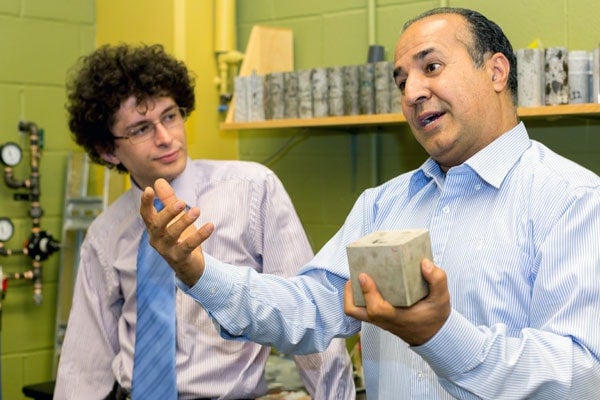
Engineering a new kind of rock music
Published: July 11, 2014
What do Beethoven and a boulder have in common?
They both compose music – while one is enjoyed over dinner, the other could be used to predict earthquakes.
In a recent paper published in Nature Scientific Reports, three researchers from U of T Engineering unveiled a new algorithm for interpreting the sound waves emitted from rock pieces when they crack and fissure. The groundbreaking research has the potential to predict seismic activity, help extract fossil fuels and more.
In the study, Civil Engineering PhD student Hamed Ghaffari and fellow authors Farzine Nasseri and Professor Paul Young, used the new algorithm to examine how rock fractures in various lab scenarios.
“When you place a log on the fire,” Ghaffari explained, “you hear the snaps and pops of the combustion of the wood. Those same principles apply to rocks and are what we use in the lab. We induce a change in the state of the material and listen to the sound it releases.”
Nasseri said the sounds give clues to where the problems – or opportunities – lie: “Every rock has a unique micro-structure mixed with fissures and pore spaces. When you apply pressure, you can hear the sound of micro-cracking in the rock and by the nature of the crackling sounds they make [you can identify] where they are and how they are moving.”
Labs producing this kind of research generally employ a more conventional method for data collection, which involves the application of force to two sides of a cylindrical rock sample.
Young and colleagues have pioneered a new method known as polyaxial loading conditions, which involves the application of force to six sides of a cubic rock sample. This more closely approximates natural earthquake conditions.
“Our lab is unique,” said Young, who oversees the laboratory where Ghaffari and Nasseri conducted their research, “and [it’s] one of the few in the world that uses three dimensional stresses together with geophysical imaging to study rock fracturing dynamically. We apply a complex series of forces in our tests so that the results more closely resemble what actually happens in nature when a real earthquakes occurs.”
In both methods of force, the applied pressure induces fracture in the rock, which spreads quickly throughout the stone. The fractures release energy in the form of a seismic wave. Ghaffari interprets these wave motions using complex network theory – a method of analyzing intricate relationships using graphical data – to learn more about the physics of micro-earthquake sources.
“Earthquakes are complex; understanding the forces behind them can be even more so,” said Ghaffari. “Our lab comes closer to approximating that complexity through 3D loading.”
Despite the difficulty in understanding these complicated series of data, Ghaffari and his colleagues are passionate about finding results. The research that the lab is conducting elevates our understanding of earthquake sources, which has wide ranging implications.
“What is the motivation behind my research? I live by it,” said Ghaffari. “I can’t separate [myself] from it. It can be frustrating, but finding order in disorder, finding connections in things that initially don’t seem connected – that is perfection.
“I am fascinated by the complex networks associated with rock fracture. It is like music, listening to the sounds that rocks release when you apply pressure to them.”



